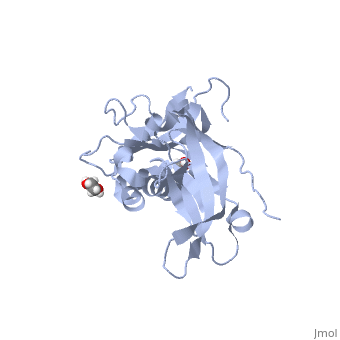5llk
From Proteopedia
(Difference between revisions)
| Line 3: | Line 3: | ||
<StructureSection load='5llk' size='340' side='right'caption='[[5llk]], [[Resolution|resolution]] 1.80Å' scene=''> | <StructureSection load='5llk' size='340' side='right'caption='[[5llk]], [[Resolution|resolution]] 1.80Å' scene=''> | ||
== Structural highlights == | == Structural highlights == | ||
| - | <table><tr><td colspan='2'>[[5llk]] is a 1 chain structure. Full crystallographic information is available from [http://oca.weizmann.ac.il/oca-bin/ocashort?id=5LLK OCA]. For a <b>guided tour on the structure components</b> use [ | + | <table><tr><td colspan='2'>[[5llk]] is a 1 chain structure with sequence from [https://en.wikipedia.org/wiki/Homo_sapiens Homo sapiens]. Full crystallographic information is available from [http://oca.weizmann.ac.il/oca-bin/ocashort?id=5LLK OCA]. For a <b>guided tour on the structure components</b> use [https://proteopedia.org/fgij/fg.htm?mol=5LLK FirstGlance]. <br> |
| - | </td></tr><tr id='ligand'><td class="sblockLbl"><b>[[Ligand|Ligands:]]</b></td><td class="sblockDat" id="ligandDat"><scene name='pdbligand=EDO:1,2-ETHANEDIOL'>EDO</scene></td></tr> | + | </td></tr><tr id='method'><td class="sblockLbl"><b>[[Empirical_models|Method:]]</b></td><td class="sblockDat" id="methodDat">X-ray diffraction, [[Resolution|Resolution]] 1.8Å</td></tr> |
| - | <tr id='resources'><td class="sblockLbl"><b>Resources:</b></td><td class="sblockDat"><span class='plainlinks'>[ | + | <tr id='ligand'><td class="sblockLbl"><b>[[Ligand|Ligands:]]</b></td><td class="sblockDat" id="ligandDat"><scene name='pdbligand=EDO:1,2-ETHANEDIOL'>EDO</scene></td></tr> |
| + | <tr id='resources'><td class="sblockLbl"><b>Resources:</b></td><td class="sblockDat"><span class='plainlinks'>[https://proteopedia.org/fgij/fg.htm?mol=5llk FirstGlance], [http://oca.weizmann.ac.il/oca-bin/ocaids?id=5llk OCA], [https://pdbe.org/5llk PDBe], [https://www.rcsb.org/pdb/explore.do?structureId=5llk RCSB], [https://www.ebi.ac.uk/pdbsum/5llk PDBsum], [https://prosat.h-its.org/prosat/prosatexe?pdbcode=5llk ProSAT]</span></td></tr> | ||
</table> | </table> | ||
== Disease == | == Disease == | ||
| - | [ | + | [https://www.uniprot.org/uniprot/DAG1_HUMAN DAG1_HUMAN] Defects in DAG1 are the cause of muscular dystrophy-dystroglycanopathy limb-girdle type C7 (MDDGC7) [MIM:[https://omim.org/entry/613818 613818]. An autosomal recessive muscular dystrophy showing onset in early childhood, and associated with mental retardation without structural brain anomalies. Note=MDDGC7 is caused by DAG1 mutations that interfere with normal post-translational processing, resulting in defective DAG1 glycosylation and impaired interactions with extracellular-matrix components. Other muscular dystrophy-dystroglycanopathies are caused by defects in enzymes involved in protein O-glycosylation.<ref>PMID:21388311</ref> |
== Function == | == Function == | ||
| - | [ | + | [https://www.uniprot.org/uniprot/DAG1_HUMAN DAG1_HUMAN] The dystroglycan complex is involved in a number of processes including laminin and basement membrane assembly, sarcolemmal stability, cell survival, peripheral nerve myelination, nodal structure, cell migration, and epithelial polarization.<ref>PMID:9851927</ref> <ref>PMID:11724572</ref> <ref>PMID:16254364</ref> <ref>PMID:17360738</ref> Alpha-dystroglycan is an extracellular peripheral glycoprotein that acts as a receptor for both extracellular matrix proteins containing laminin-G domains, and for certain adenoviruses. Receptor for laminin-2 (LAMA2) and agrin in peripheral nerve Schwann cells. Also acts as a receptor for M.leprae in peripheral nerve Schwann cells but only in the presence of the G-domain of LAMA2, and for lymphocytic choriomeningitis virus, Old World Lassa fever virus, and clade C New World arenaviruses.<ref>PMID:9851927</ref> <ref>PMID:11724572</ref> <ref>PMID:16254364</ref> <ref>PMID:17360738</ref> Beta-dystroglycan is a transmembrane protein that plays important roles in connecting the extracellular matrix to the cytoskeleton. Acts as a cell adhesion receptor in both muscle and non-muscle tissues. Receptor for both DMD and UTRN and, through these interactions, scaffolds axin to the cytoskeleton. Also functions in cell adhesion-mediated signaling and implicated in cell polarity.<ref>PMID:9851927</ref> <ref>PMID:11724572</ref> <ref>PMID:16254364</ref> <ref>PMID:17360738</ref> |
<div style="background-color:#fffaf0;"> | <div style="background-color:#fffaf0;"> | ||
== Publication Abstract from PubMed == | == Publication Abstract from PubMed == | ||
| Line 27: | Line 28: | ||
__TOC__ | __TOC__ | ||
</StructureSection> | </StructureSection> | ||
| + | [[Category: Homo sapiens]] | ||
[[Category: Large Structures]] | [[Category: Large Structures]] | ||
| - | [[Category: Bigotti | + | [[Category: Bigotti MG]] |
| - | [[Category: Bozzi | + | [[Category: Bozzi M]] |
| - | [[Category: Brancaccio | + | [[Category: Brancaccio A]] |
| - | [[Category: Cassetta | + | [[Category: Cassetta A]] |
| - | [[Category: Covaceuszach | + | [[Category: Covaceuszach S]] |
| - | [[Category: Konarev | + | [[Category: Konarev PV]] |
| - | [[Category: Lamba | + | [[Category: Lamba D]] |
| - | [[Category: Sciandra | + | [[Category: Sciandra F]] |
| - | + | ||
| - | + | ||
| - | + | ||
Current revision
Crystal structure of human alpha-dystroglycan
| |||||||||||

